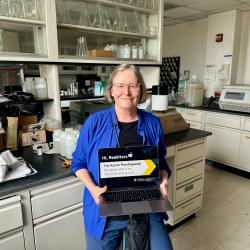Geology Ph.D. Student Plans to Use Competitive Defense Fellowship to Save Lives from Landmines
On January 17, 1994, the Northridge earthquake struck Los Angeles, killing dozens, injuring thousands and causing $25 billion in damage. The 6.7 magnitude earthquake also made a lasting impression on five-year-old Heidi Myers, who experienced it firsthand.
 “Growing up in Southern California, earthquakes were a fairly common occurrence, but Northridge was something unique,” she recalled. “Our family’s house jumped off of its foundation a few feet and then back during the course of the earthquake. We lived fairly close to the epicenter so it was the most intense one I had ever experienced.”
“Growing up in Southern California, earthquakes were a fairly common occurrence, but Northridge was something unique,” she recalled. “Our family’s house jumped off of its foundation a few feet and then back during the course of the earthquake. We lived fairly close to the epicenter so it was the most intense one I had ever experienced.”
That earthquake sparked Myers’ interest in what happens in the ground beneath us.
“Through the trauma of the Northridge earthquake, I became interested in geology and what processes were happening underneath our feet,” she said. “There’s just so much unknown about this planet that we’re standing on.”
Myers carried that curiosity with her to the University of Maryland where she is pursuing her Ph.D. in geology.
“I was finishing up my undergraduate studies and I became really fascinated with the Earth’s geodynamo and understanding how our magnetic field is created,” she said. “One of my professors told me about a large-scale experiment studying the geodynamo that was happening at the University of Maryland and pointed me in the direction of Professor Dan Lathrop.”
Myers, who was headed down a different career path working in access control systems at the time, decided to take a chance and apply to graduate school at Maryland to learn more about the Earth’s magnetic field and other topics that intrigued her.
“Thankfully, Dan Lathrop is interested in some of the other things I wanted to study and has encouraged me to tackle those as well,” Myers said.
One of the other topics she became passionate about was using geophysical techniques to find landmines and other unexploded ordnances. Myers’ husband was in the military, and through his experiences she has seen how dangerous undetected landmines can be, and she wanted to do something about it.
“My husband and I were stationed in Okinawa, Japan, for several years and I saw a lot of our friends and his coworkers return home from war maimed or not return at all because of landmines and IEDs,” she recalled. “That horrified me and got me thinking about how we could use geophysics to better identify where explosives are located.”
Myers’ Ph.D. research focuses on how to tackle this issue, and she has been awarded the Department of Defense’s National Defense Science and Engineering Graduate (NDSEG) Fellowship to continue this research for three years.
“I was elated when I found out I was going to receive the fellowship,” Myers said. “It's such an amazing opportunity to work with the Department of Defense and use those additional research channels that I’ll have access to through this fellowship.”
The program, established in 1989 by direction of Congress and sponsored by the U.S. Army, Navy, and Air Force, serves as a means to increase the number of citizens trained in science and engineering disciplines of military importance.
In her research, Myers combines ground-penetrating radar, magnetometers (instruments that measure Earth's magnetism) and other geophysical technologies on a drone to detect anomalous zones underneath the ground’s surface. When a part of the ground is determined to be different from the ground surrounding it, it may indicate the presence of a landmine. These tools, when used together, can serve as a way to detect landmines from a distance.
“The military and humanitarian groups still largely use imprecise or ineffective methods like hand-held metal detectors to find landmines,” Myers said. “With my research, my aim is to create a better way to find them and hopefully save some people from losing limbs or their lives.”
Written by Chelsea Torres







